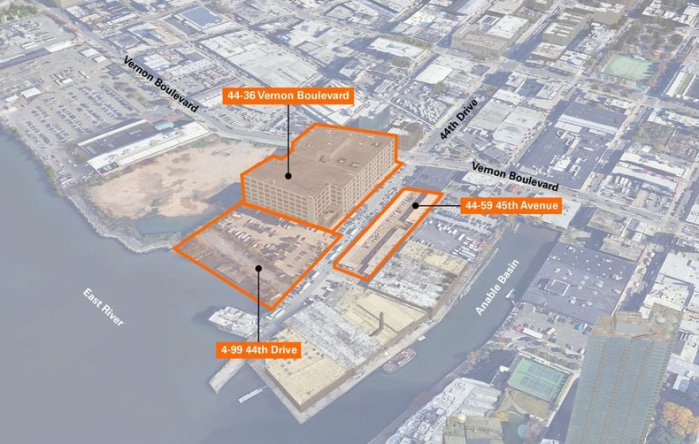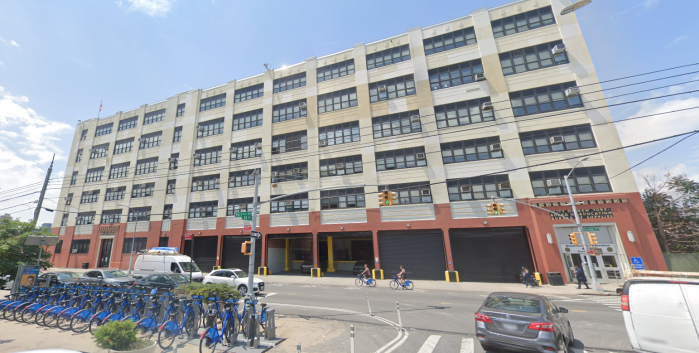
Courtesy of the Dept. of City Planning
Feb. 6, 2025 By Ethan Marshall
New York City plans to release a request for expressions of interest this spring for 44-36 Vernon Blvd. in Long Island City, according to Crain’s New York Business. The property was once meant to serve as Amazon’s headquarters before the company abandoned the plans in 2019 following severe opposition from many residents and local leaders.
The city is looking to rezone Long Island City and create 14,000 homes in the neighborhood. In addition to taking a look at this address, which houses a 672,00-square-foot warehouse previously occupied by the Department of Education, the city is also considering two adjacent city-owned parking lots that belong to the Transportation and Small Business Services departments. These lots were also part of the property where Amazon planned to build its new headquarters.
The New York City Economic Development Corporation will release the request sometime during spring 2025. In the area near the waterfront of the Anable Basin inlet, where Amazon had initially planned to build its headquarters, they will ask for uses that serve the community, as well as commercial and light industrial uses.
Responses from the community that could help the city decide what potential projects would be feasible there will be accepted until the summer. This feedback could ultimately lead to the Economic Development Corporation making a more formal request for proposals once the neighborhood’s rezoning is completed by the end of 2025. A seven-month review would take place after the request is released this spring, culminating in a City Council vote.
Long Island City’s rezoning, known as the Long Island City Neighborhood Plan, is expected to span from Dutch Kills to Hunters Point. In June 2024, a draft plan was released calling for high-rise housing along the Hunters Point waterfront and further east near Court Square, as well as high- and medium-density, mixed-use developments on several blocks north of the Queensborough Bridge near Dutch Kills.
In addition to providing plenty of new housing, the Long Island City Neighborhood Plan, spearheaded by Council Member Julie Won, also calls for a continuous public walkway to improve access to the East River waterfront.
In the years following Amazon’s withdrawal from developing its new headquarters in New York City, neighborhood advocates called for approximately two-thirds of the building at 44-36 Vernon Blvd. to be given to the Western Queens Community Land Trust, a non-profit made up of activists, small business owners, professors, artists, students and community members who want more democratic and equitable land in Western Queens.
Under this proposal, the land trust would renovate that portion of the building before renting out space at affordable rates to local businesses, community groups and artists. Such ideas include devoting the ground floor to food justice with the opening of a supermarket, a theater, a daycare, artist workshops, music studios and adult-education centers on the upper floors and a garden on the roof of the building.

The DOE building at 44-36 Vernon Blvd. Photo via Google Maps.
Dubbed the Queensboro People’s Space, this proposal earned the support of multiple local elected officials, including Council Members Julie Won, Shekar Krishnan, and Tiffany Cabán. This plan stems from the widespread belief that the building is underutilized, even though the Department of Education uses it for offices, storage, and dry food distribution across public schools in the city.
Organizers for the Queensboro People’s Space projected such a transformation would result in 850 jobs within the building, with the businesses there generating approximately $11.5 million annually in rent income. While it remains to be seen whether or not this proposal is taken into consideration during the city’s request for expressions of interest in 44-36 Vernon Blvd., the Department of Education would likely need to be willing to relinquish the space needed.
When Amazon planned to build its New York City headquarters in Long Island City, many New Yorkers were critical of the $3 billion in financial incentives that New York State and New York City gave the company. Many people also had concerns that an influx of new, highly paid workers might push out existing residents and add to congestion on the city’s already-overcrowded subway.
